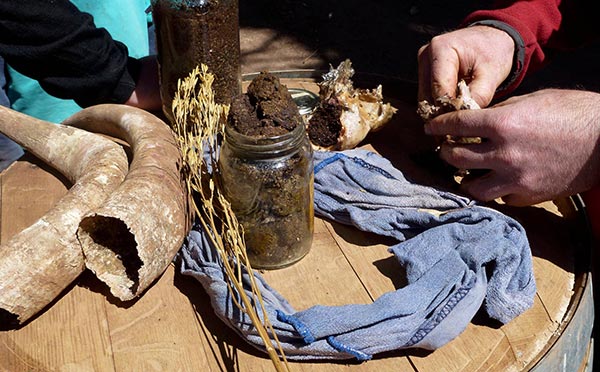 |
  
|
Biodynamic AgricultureBiodynamic agriculture is not a modern innovation, but rather a throwback to the Dark Ages. Skeptoid Podcast #26  by Brian Dunning Today we're going to pull a cork and pour ourselves a glass of the latest fashion in winemaking: biodynamic agriculture. If you're not familiar with biodynamics, the best way to think of it would be as a magic spell cast over an entire farm. Biodynamics sees an entire farm as a single organism, with something that they call a life force. Believers say that this life force can be increased, thus improving crop quality and health, by following conventional organic methods plus the application of a special magical potion. The potion is not intended to have any direct physical effect — its intent is to charge up the life force of the farm. The word biodynamic literally means life force, according to its Greek roots bio and dyn. Rudolf Steiner was a philosopher, a multi-faceted artist, a playwright, and a self-described clairvoyant. He gave a series of eight lectures in Germany in 1924, which became the essential bible of biodynamics. To Steiner's credit, he always insisted that his students test everything he said and not take it at face value; but to his detriment, he did no testing of his own, but rather described the methods to be followed based only on his own inspiration. Steiner's eight lectures are available on the Internet, and if you're curious you should look them up and read them. They start with some conventional sounding discussion of soil chemistry and nutrients, but then devolve into a progressively more vague lecture about non-physical beings and elemental forces. Now you probably think I'm coming across as overly cynical or that I'm deliberately painting biodynamics in a negative or irrational light. I don't want you to feel that I'm coloring this in any way, or at least in any undeserved way, so please draw your own conclusions from what I'm about to read. This comes directly from a prominent biodynamics website, so this is their description, not mine. The potion consists of nine ingredients (or preparations, as Steiner described them), numbered 500 through 508. Here are their descriptions and the instructions:
It doesn't say so but I think you're supposed to chant "Double double toil and trouble, fire burn and cauldron bubble" while preparing it. Notice that the potion is applied to the compost in the ratio of one sixteenth of an ounce per ten tons of compost. Biodynamicists describe this as a homeopathic amount, which means diluted to undetectable levels, which certainly applies in this case. But again, the potion is not intended to have any direct physical effect. It's there to stimulate the life force. I was not able to find any proposals describing what the mechanism for this effect is alleged to be, or exactly what the effect is, other than the vague phrase "strengthen the life force." If you're wondering why cows' horns figure so prominently in the potion, this explanation comes from one of Steiner's lectures:
Remember, Steiner encourages you to test this scientifically. All you'll need is an astral and etheric formative force gauge. I think they have them at Radio Shack. Frankly, I'm shocked to see adults in industrialized nations mixing magic potions in the twenty first century. If they were doing it for ceremonial reasons, or to honor some folk tradition, fine; but doing it earnestly in a sincere effort to improve a harvest is alarming. Essentially, we're talking about witchcraft and sorcery being employed as a modern farming tool, today, in the United States. Go to your local liquor store and you'll find wines from biodynamic farms. Pick up a wine magazine and you'll find reviews of biodynamic wines. This phenomenon has already infiltrated our daily lives. Is this a commentary on the state of our educational system? Does it reflect a change in what parents are teaching children? I'm not persuaded by the anecdotal evidence either. What you'll usually hear from biodynamicists is something like "I know it sounds weird, but the fact is the wines are actually better, and that's an undeniable difference that you can taste." I'm sure there actually is a difference that you can taste. No two wines ever taste alike. Grapes from every vineyard in the world taste different, and grapes from the same vineyard taste different each successive year. That's why there are good vintages and bad vintages. Any experienced vintner making the same wine from the same grapes in the same vineyard will easily be able to tell you which vintage a given bottle is from. Whether the growing method changed from conventional to organic to biodynamic or to anything else, the next batch of wine must taste different. That's a fact of winemaking. If ever there was a science where a valid controlled trial was absolutely impossible, it's winemaking. Anecdotal reports that wine quality improved after the farm became biodynamic can't be given any credence. Not only is "improved" a completely subjective matter of opinion that will differ among all wine drinkers, but any chromatographic analysis of the chemical content of the wine must be different year after year, whether the vineyard cast a magic spell over their compost or not. Neither any actual effect nor any causal relationship can be evidenced. No doubt there are valid marketing reasons for making and selling biodynamic wines or other crops — there are always going to be customers who want it. And that's fine. But please don't teach your children that magic potions and non-physical beings are the way to achieve success in agriculture or anything else.
Cite this article:
©2025 Skeptoid Media, Inc. All Rights Reserved. |